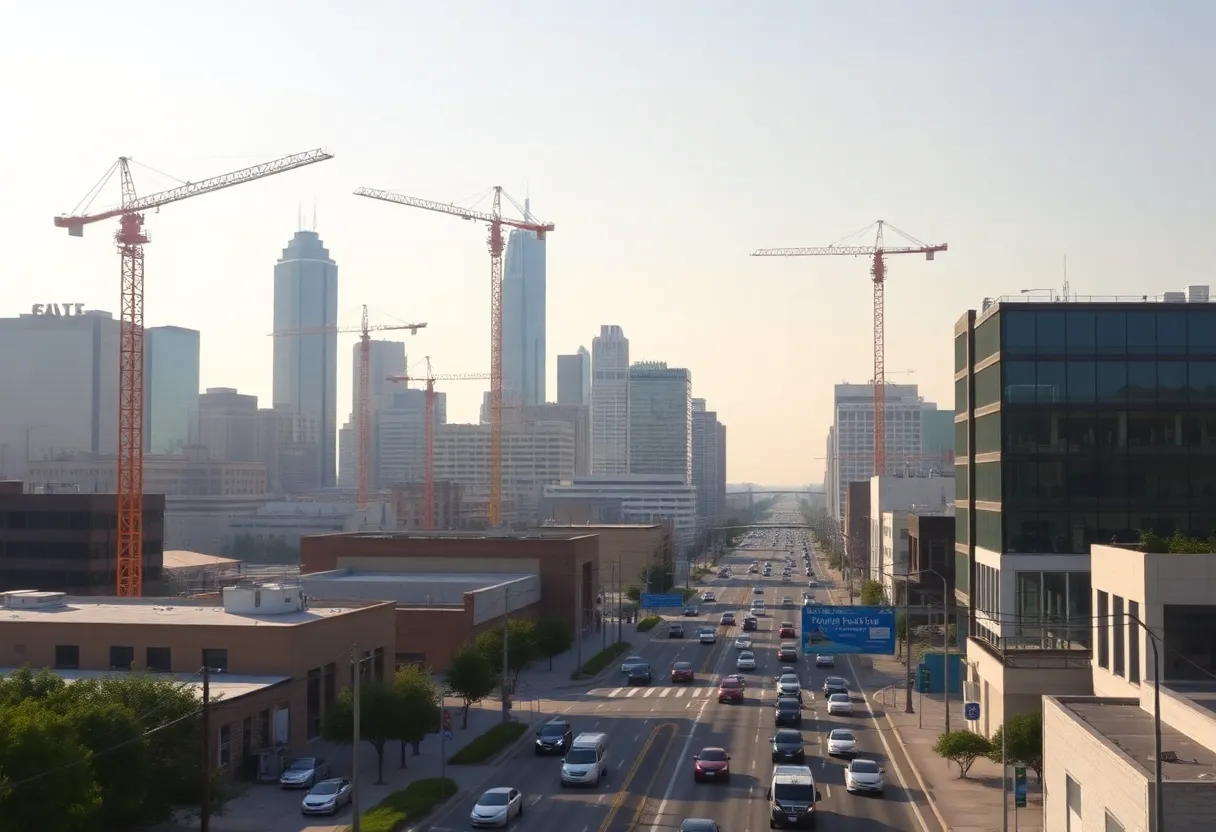Oklahoma City, October 21, 2025
At the State of the Region event, Oklahoma City’s business community gathered to discuss economic expansion projections and pressing infrastructure issues. Leaders highlighted the need for public-private partnerships to tackle challenges including housing shortages and transportation bottlenecks, forecasting significant job growth but noting the importance of coordinated action to ensure sustainable development. The event illustrated a commitment to align workforce development with industry needs amid these pressures.
Oklahoma City Business Leaders Tackle Growth and Challenges at State of the Region Event
Oklahoma City – Central Oklahoma’s business community convened recently for the State of the Region event, where leaders delved into critical data on economic expansion and pressing infrastructure deficiencies. The gathering spotlighted rapid urbanization in the region, forecasting around 50,000 new jobs by 2030, while also confronting significant hurdles in housing and transportation that could impede progress.
The event brought together key stakeholders to analyze current trends and future projections for the area’s economy. Discussions centered on how Oklahoma City’s growth trajectory is outpacing infrastructure development, creating urgent needs for coordinated action. Business executives, policymakers, and experts examined datasets revealing robust job creation in sectors like technology, healthcare, and logistics, which are driving the region’s appeal as a business hub.
One major focus was the housing shortage, as population influxes strain available residential options. Leaders highlighted how this gap affects workforce retention and overall quality of life, with calls for innovative solutions to boost affordable housing stock. Transportation emerged as another bottleneck, with analyses showing outdated roadways and public transit systems struggling to handle increased traffic volumes. Panelists explored how these issues interconnect, potentially slowing economic momentum if not addressed swiftly.
Calls for Public-Private Partnerships
To counter these challenges, the event emphasized the importance of public-private partnerships. These collaborations were positioned as essential for funding and implementing large-scale projects in infrastructure and housing. For instance, joint ventures could accelerate the development of mixed-use neighborhoods that combine residential, commercial, and transit elements, easing urban congestion. Attendees stressed that such partnerships would leverage private sector efficiency with public resources to fill funding gaps in municipal budgets.
Transportation improvements were a recurring theme, with data underscoring the need for expanded rail and bus networks to connect growing suburbs with downtown employment centers. Leaders advocated for investments in smart infrastructure, like traffic management systems, to optimize existing resources while planning for future demands. The discussions painted a picture of a region at a crossroads, where proactive measures could turn potential obstacles into opportunities for sustainable development.
Workforce Development as a Key Priority
Amid the optimism about job growth, the need for robust workforce development programs took center stage. With 50,000 new positions on the horizon, the region faces a skills mismatch that could leave many opportunities unfilled. Programs targeting vocational training, apprenticeships, and upskilling initiatives were recommended to prepare local talent for high-demand roles. This focus aims to ensure that economic benefits reach a broad cross-section of the population, promoting inclusivity in the job market.
Educational institutions and businesses were urged to align curricula with industry needs, particularly in emerging fields like renewable energy and digital services. The event’s data sessions revealed that current workforce participation rates lag behind job projections, reinforcing the urgency of these efforts. By investing in human capital, leaders believe Central Oklahoma can maintain its competitive edge and support long-term prosperity.
Broader Context of Regional Growth
The State of the Region event occurs against a backdrop of steady economic recovery and investment in Oklahoma City. Over the past few years, the area has seen influxes of businesses relocating for its central location, lower costs, and quality of life. However, this success amplifies the infrastructure gaps discussed, as rapid urbanization—fueled by migration and natural population growth—puts pressure on aging systems.
Historical data from similar regional forums indicate that past initiatives, such as downtown revitalization projects, have yielded positive results in attracting talent and capital. Building on this, the current conversations aim to set a roadmap for the next decade, ensuring that growth is equitable and resilient. The emphasis on data-driven decisions underscores a commitment to evidence-based strategies that address both immediate and long-term needs.
In summary, the event served as a vital platform for aligning visions among business leaders, highlighting the interplay between economic opportunities and infrastructural realities. As Central Oklahoma positions itself for substantial job expansion, the push for collaborative action and workforce readiness will be crucial to realizing its full potential.
FAQ
What was the main focus of the State of the Region event in Oklahoma City?
The event focused on key data on economic growth and infrastructure gaps in Central Oklahoma.
What job growth is projected for Central Oklahoma by 2030?
Rapid urbanization in Oklahoma City is projected to bring 50,000 new jobs by 2030.
What challenges were discussed at the event?
Discussions highlighted housing shortages and transportation challenges in the region.
How can these challenges be addressed according to the event?
Public-private partnerships are urged to bridge the divides in housing and infrastructure.
Why is workforce development important for the region?
Workforce development programs are needed to sustain economic momentum and prepare for the projected job growth.
Key Features Chart
The following table outlines the key features discussed at the State of the Region event, including projections and priorities for Central Oklahoma’s business landscape.
| Feature | Description |
|---|---|
| Job Growth Projection | 50,000 new jobs by 2030 due to rapid urbanization in Oklahoma City |
| Housing Challenges | Shortages affecting workforce retention and quality of life |
| Transportation Issues | Outdated systems struggling with increased traffic from growth |
| Public-Private Partnerships | Essential for funding infrastructure and housing projects |
| Workforce Development | Programs for training and upskilling to meet job demands |
Deeper Dive: News & Info About This Topic
HERE Resources
Skirvin Hilton Hotel Completes $22 Million Renovation
Oklahoma City: Rising Home Prices Challenge Buyers and Benefit Sellers
Groundbreaking for 200-Unit Affordable Housing Project in Midwest City
Pioneer Grain Launches Drought-Resistant Wheat in Oklahoma
Oklahoma Tourism Board Launches Campaign to Promote Native American Heritage
DataSync Solutions Acquires Rival Analytics Provider for $75 Million
Petco Closes Local Store in Oklahoma City Amid Restructuring
Devon Energy Announces Major Fracking Expansion in Anadarko Basin
Oklahoma City Gas Prices Fall to $2.89 per Gallon
Oklahoma City Home Prices Surge by 5.2% in September





